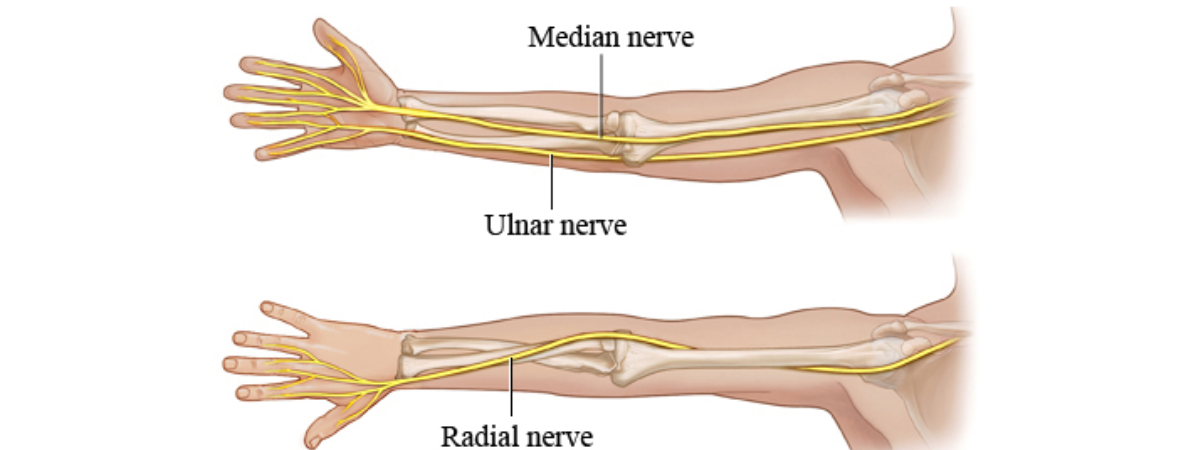Working Time
| Sunday - Friday | 07:00 AM - 11:00 PM |
| Saturday | Closed |
| Other Time | On Appointment |
Book Appointment

The human hand, with its intricate network of nerves, is a testament to the complexity of our anatomy. Nerves play a crucial role in facilitating the delicate movements and sensations that make our hands so remarkable. In this exploration, we'll delve into the major nerves of the hand, understanding their pathways, functions, and the vital roles they play in our daily lives.
Understanding the Hand's Neural Landscape:
The hand is a marvel of precision, housing an intricate web of nerves responsible for motor and sensory functions. The major nerves of the hand originate from the brachial plexus, a network of nerves formed by the cervical and upper thoracic spinal nerves. As these nerves travel down the arm, they branch out, giving rise to specific nerves that innervate different areas of the hand.
1. Median Nerve:
- Pathway: The median nerve originates from the lateral and medial cords of the brachial plexus, primarily from nerve roots C6 to T1.
- Course: This nerve courses down the arm, passing through the carpal tunnel—an anatomical passageway in the wrist—before branching out into the hand.
- Function: The median nerve is a major player in hand function, controlling muscles responsible for thumb opposition and providing sensation to the palm, thumb, index, and middle fingers.
- Pathway: Arising from the medial cord of the brachial plexus (C8 to T1), the ulnar nerve travels along the inner aspect of the arm.
- Course: As it descends, the ulnar nerve passes through the cubital tunnel at the elbow and further along the ulnar side of the forearm. It eventually reaches the hand.
- Function: The ulnar nerve is essential for fine motor movements, controlling the muscles that enable precise finger and hand motions. It also provides sensation to the pinky and the ulnar side of the ring finger.
- Pathway: Originating from the posterior cord of the brachial plexus (C5 to T1), the radial nerve follows a course along the back of the arm.
- Course: As it travels down the arm, the radial nerve winds around the humerus bone, reaching the posterior aspect of the forearm and hand.
- Function: The radial nerve is crucial for extending the wrist and fingers, providing motor control to the muscles that enable these movements. It also contributes to the sensation of the dorsal aspect of the hand.
- Pathway: Emerging from the lateral cord of the brachial plexus (C5 to C7), the musculocutaneous nerve takes a course along the upper arm.
- Course: It then pierces the coracobrachialis muscle before running down the anterior aspect of the arm.
- Function: The musculocutaneous nerve is primarily a motor nerve, innervating muscles responsible for elbow flexion. It also provides sensation to the lateral forearm.
Beyond the major nerves mentioned, the radial, median, and ulnar nerves give rise to various branches that intricately supply specific regions of the hand.
- Radial Nerve Branches: The radial nerve branches into superficial and deep branches, contributing to the innervation of the dorsal aspect of the hand and fingers.
- Median Nerve Branches: The median nerve gives rise to branches such as the recurrent branch and the palmar digital nerves, supplying motor control and sensation to specific muscles and areas of the hand.
- Ulnar Nerve Branches: The ulnar nerve branches into the deep and superficial branches, playing a crucial role in innervating the intrinsic muscles of the hand and providing sensation.
Understanding the major nerves of the hand is crucial in the clinical setting, particularly when addressing conditions that affect hand function. Conditions such as carpal tunnel syndrome, cubital tunnel syndrome, and peripheral neuropathies can impact these nerves, leading to symptoms such as pain, weakness, and numbness in specific regions of the hand.
- Carpal Tunnel Syndrome:
In carpal tunnel syndrome, compression of the median nerve within the carpal tunnel results in symptoms such as pain, numbness, and tingling in the thumb, index, and middle fingers. - Cubital Tunnel Syndrome:
Compression of the ulnar nerve at the cubital tunnel can cause symptoms like tingling and weakness in the pinky and ring fingers. This condition is often associated with the sensation of the "funny bone." - Radial Nerve Injuries:
Injuries to the radial nerve can lead to deficits in wrist and finger extension, impacting the ability to perform various hand movements.
The hand's neural landscape is a symphony of complexity, with major nerves orchestrating precise movements and relaying sensations. Understanding the pathways and functions of the median, ulnar, radial, and musculocutaneous nerves provides insight into the intricate balance that allows us to grasp, touch, and manipulate our environment.
In the realm of healthcare, recognizing the clinical significance of these nerves is crucial for diagnosing and treating conditions that affect hand function. As we navigate the intricacies of the major nerves of the hand, we gain a deeper appreciation for the extraordinary coordination required to perform the myriad tasks that our hands accomplish every day.
About the Author: Dr. Srikanth Varma Racherla
Dr. Srikanth Varma Racherla, a Specialist Orthopedic Surgeon in Al Nahda, Dubai, boasts a stellar academic background with an MBBS and MS in Orthopedics. His expertise spans Reconstructive Microsurgery, Hand Surgery, Peripheral Nerve Surgery, and Tendon Repairs and Transfers. Renowned for his proficiency in trauma, hand, and wrist surgeries, Dr. Srikanth Varma exemplifies a commitment to comprehensive and advanced orthopedic care, enriching the well-being of his patients with personalized and effective treatment.
Recent Posts
Navigating the Dislocation Dilemma: Can Your Finger Take the Hit?

Read More
Decoding Connective Tissues: Unveiling the Differences Between Tendons and Ligaments

Read More
Navigating the Road to Recovery: Understanding the Expected Recovery Time of a Torn Bicep

Read More
Pinched Nerve? Here’s 7 Home Remedies to Help Reduce Some Pain

Read More
Unraveling the Mechanics: Can You Dislocate Your Finger?

Read More

